#Parure
Explore tagged Tumblr posts
Text

A four piece antique amethyst parure, 1830s, comprising of a graduating oval faceted necklace, a pair of circular- and pear cut amethyst ear pendants with dangling amethysts and an amethyst brooch, all mounted in gold.
Source - IG
#jewelry#gold#jewellery#antique#antique jewelry#victorian#amethyst#amethyst pendant#parure#georgian era#georgian fashion#1800s#19th century
807 notes
·
View notes
Text
Mid-Mentury Aquamarine Suite

"Aqua parure including a necklace, 2 pairs of earrings, a bracelet, a ring and a pair of clips by Seaman Schepps in original fitted box."
- 1st Dibs
"Pat Saling is well-known for her signed pieces from Art Deco through mid-century. This Seaman Schepps aquamarine suite from the 1950s is a true find for collectors who prefer retro and vintage pieces to those of the Georgian and Victorian time periods. The aquamarines are of the finest quality – deep and clear, conjuring up sea-blue waters. The pieces in the suite combine both aquamarine beads and faceted small and large pear-shaped stones in a warm gold setting, with various earring and pendant options and a central necklace with an oval-set aquamarine and gold clasp."
- The Jewellery Editor

#parure#set#jewelry set#jewelry collection#jewelry suite#jewelry#jewellery#jewels#necklace#necklaces#earring#earrings#bracelet#bracelets#rings#ring#ear clips#pendants#aquamarines#aquamarine#gold#seaman schepps#1st dibs#tiaras crowns#tiarascrowns#tiara crown#tiaracrown
194 notes
·
View notes
Text
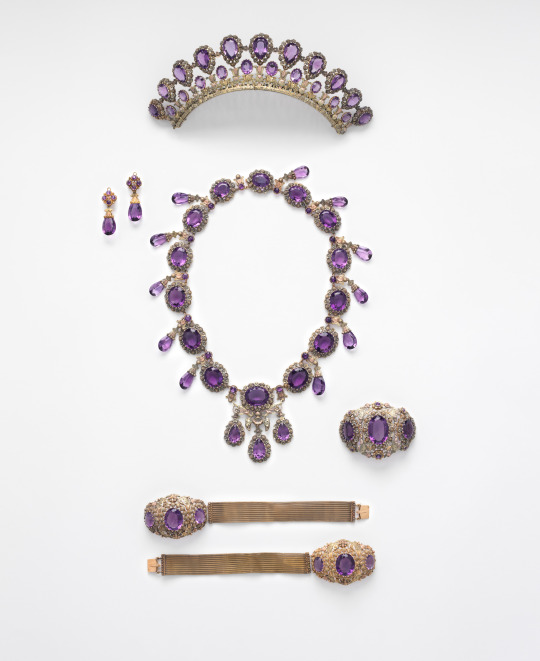
Parure
c.1830
Paris, France
The MET (Accession Number: 32.100.320)
#parure#jewelry#historical fashion#fashion history#1830s#romantic era#amethyst#gold#france#july monarchy#1830#19th century#necklace#bracelet#brooch#earrings#comb#accessories#the met#popular
1K notes
·
View notes
Text
Georgian/Regency Coral Jewelry

Adèle Romany (French, 1769–1846) • Portrait of a Woman at a Pianoforte • 1808
I came across so many portraits from the early 19th century of young women wearing coral jewelry that I had to look into why.

Thomas Barber (British, 1771–1843) • Lady Caroline Gordon, Lady Chesham (1785-1866) • Between 1805-1815
It was believed by the people of the era that coral contained properties that protected the health and well-being of the wearer. Coral was worn mostly by young women and children because their health was considered the most vulnerable. If the coral remained bright, it signified its wearer was in good health. If it turned dull, it indicated that the person wearing it was either ill or soon to be. Wearing coral for a portrait helped to portray that the sitter was "the picture of health".





Jewelry sets, such as this one, were called parure. The comb in the upper center was called a diadem. These matching sets are evident in portraits (see the Romany portrait), mostly coral or pearl studded.

Adèle Romany (1769-1846) • Portrait of a Young Piano Player Holding a Music Score (Miss Thevenet de Montgarrel) • c. 1802
#art#art history#historical fashion#fashion history#georgian jewelry#regency era portraits#coral jewelry#adèle romany#thomas barber#regency fashion#19th century fashion#early 19th century art#portraiture#diadem#parure#symbolic jewelry
140 notes
·
View notes
Text

#parure
#performance#parure#installation art#artistetextile#artists on tumblr#mixed media#technique mixte#broderie#fontencomble#corps#art
5 notes
·
View notes
Text



{{Disponible en boutique}}
Ɍꚶᗹꚶꕷ ᗹԸᕔᙅҜꘘᎽɌꗛ
HERBARIUM : Ronce (Rubus Fruticosus)
LAPIDARIUM : Hypersthène
LIEU DE CUEILLETTE : Maison Loye (Bourgogne)
#the crypt and the incubus#witch jewelry#electroformed jewelry#botanical jewelry#parure#boucles d'oreilles#pendentif#rubus fruticosus#ronce#hypersthene
3 notes
·
View notes
Text

Detail from the Portrait of Hortense de Beauharnais by Jean-Baptiste Regnault, 1810
#hortense#Hortense de Beauharnais#Napoleon’s family#jewelry#jewellery#Parure#19th century#napoleonic era#first french empire#napoleonic#french empire#art#Jean-Baptiste Regnault#Regnault#French art#painting#portrait#holland#queen#royalty#empire style#napoleon#empire#empire period#regency#necklace#bodice#fashion#fashion history#the netherlands
34 notes
·
View notes
Text

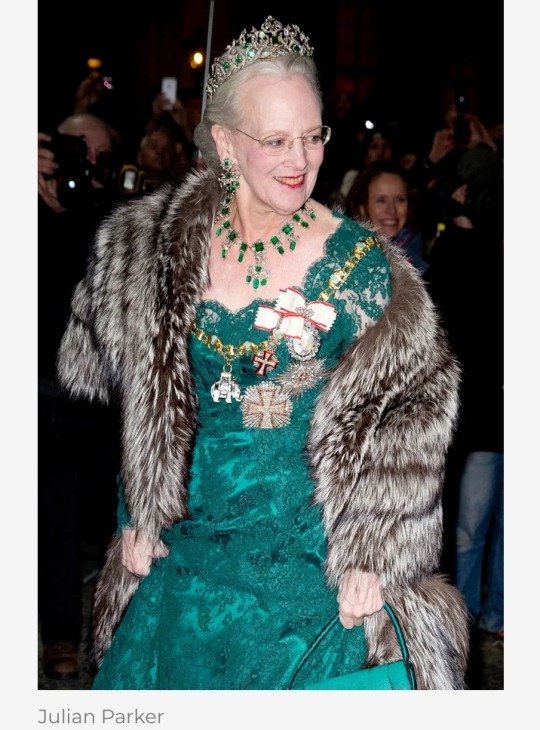
The Danish Emerald Parure
Perhaps the jewel in the Queen’s crown collection is her Emerald Parure.
Created in 1840 for Queen Caroline Amalie, the set includes a tiara, a necklace, earrings, and a corsage brooch.
27 of the diadem’s emeralds date back to 1723, making the collection incredibly historically significant.
While the colour is in-keeping with the current Queen Margrethe’s more outlandish style, we can see Crown Princess Mary reaching for the tiara or earrings for big state events.
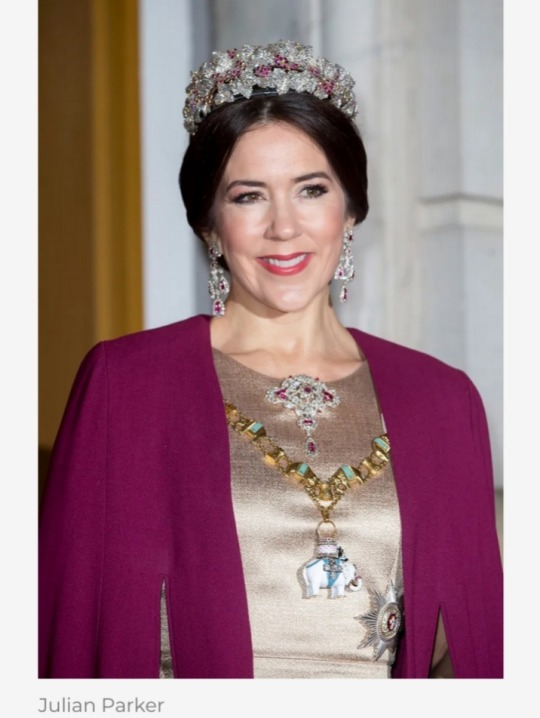
The Danish Ruby Parure
Crown Princess Mary has already made herself familiar with this unique piece.
Like a naughty daughter venturing into a mother's wardrobe, Mary has not waited until her ascension to borrow this spectacular ruby set even adorning the headpiece for her and Crown Prince Frederik's official ascension portraits.
Made for the coronation of Napoleon in 1804, the parure includes the intricately designed crown, necklace, brooch, and earrings.

The Danish Crown Diamond Parure
This necklace, brooch, and earring set has timeless beauty.
Made for Queen Caroline Amalie in 1840, the parure is reserved only for the most significant occasions, such as the wedding of Mary and Frederik in 2004.
As such, the pieces will undoubtedly hold a special place in both Margrethe and Mary's hearts.
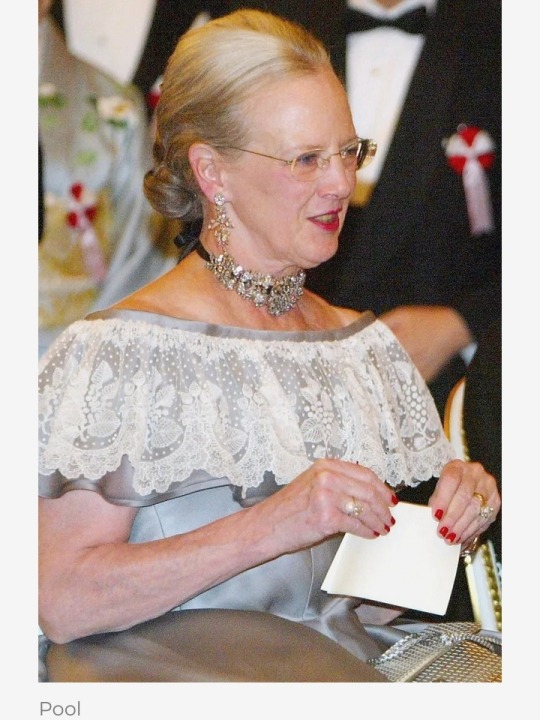
The Floral Bracelet Choker
The choker has recently come back into fashion, and Margarethe shows this floral piece off well in a boat-necked gown.
This is one of Margrethe's favourite pieces, leading us to wonder if she will part with her jewels as well as the crown on Sunday.
The timeless piece belonged to Queen Louise of Sweden and was initially designed as a bracelet, though the always-innovating Margrethe started wearing it as a choker in the 1980s.

The Crown Pearl and Ruby Parure with the Floral Aigrette Tiara
This parure is an extensive set, including a large pearl necklace, pearl, ruby and diamond earrings, two pearl clasps, and two ruby and diamond links.
The parure was worn here with the Floral Aigrette diadem.
The leafy diamond structure was acquired by King Frederik IX for Queen Margrethe's mother in the 1960s.
The piece is versatile and can be separated to lessen the overall effect, which may be favourable for Mary's more subtle style.
Queen Margrethe has revealed that her hairdresser enjoys styling her hair using the dazzling pieces.
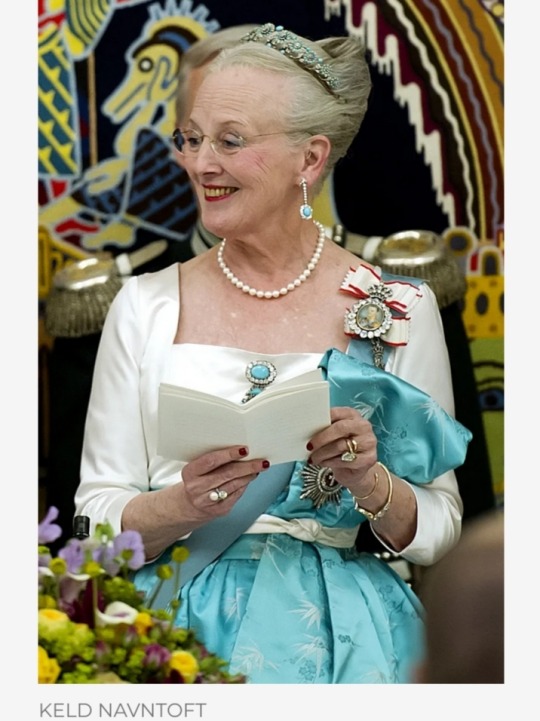
The Turquoise Daisy Bandeau
This girlish beauty has already been passed along to Mary.
The flowery headpiece is elegant and playful, featuring a band of delicate daisies in a bold aquamarine.
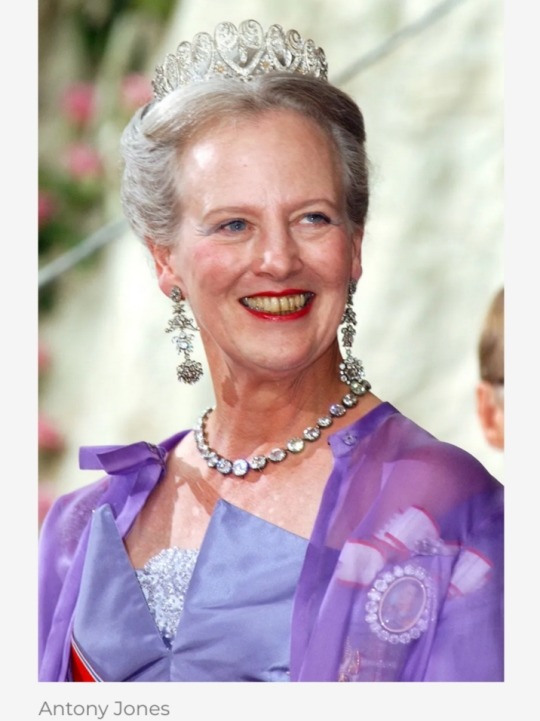
The Palmette Tiara
This curly crown is more effeminate than Mary's current fashion would indicate. Having said that, its intricate beauty and alluring sparkle is undeniable.
The tiara is made up of diamond palmettes and flowers, set upon a link-effect diamond base.
The piece was created in 1856 for Princess Louise of Prussia when she married Grand Duke Frederick.
Queen Ingrid lent Queen Margrethe the diadem in the 1960s, before she officially inherited it on her mother's passing in 2000.
Most notably, she has worn it to the wedding of Crown Prince Haakon of Norway and the wedding of Princess Märtha Louise of Norway.
#Queen Margrethe II#Crown Princess Mary of Denmark#Queen Mary of Denmark#Danish Royal Family#Denmark#Queen’s Crown Collection#tiaras#diadems#Danish Emerald Parure#Danish Ruby Parure#Danish Crown Diamond Parure#Floral Bracelet Choker#Crown Pearl and Ruby Parure with the Floral Aigrette Tiara#Turquoise Daisy Bandeau#Palmette Tiara#parure
5 notes
·
View notes
Text
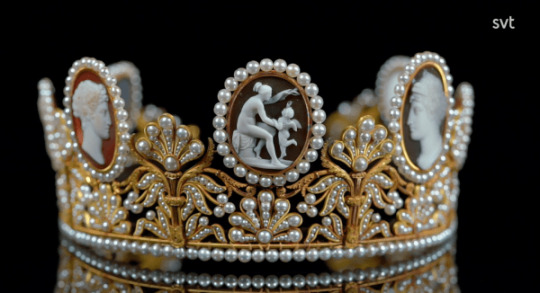
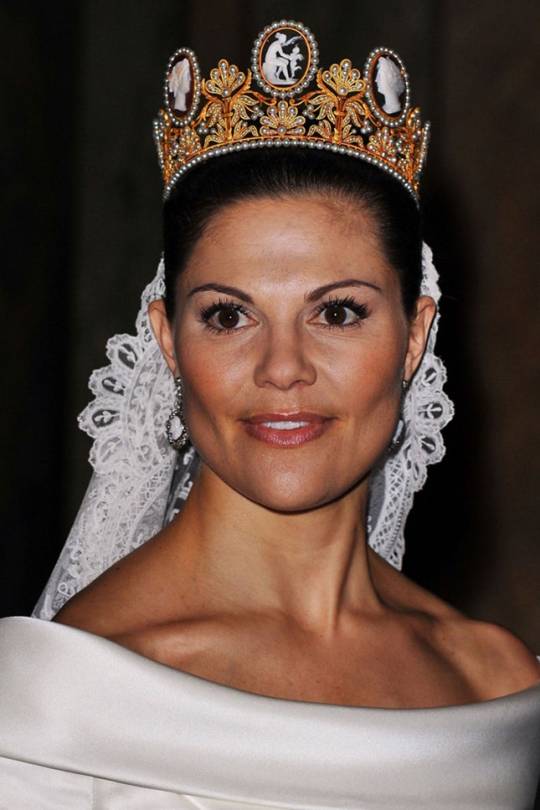
The unique gold, pearl, and cameo tiara from the Swedish royal vaults is packed with history and symbolism, from its initial creation story in Napoleonic France to the tales told by the individual cameos in the piece. Today, we’re unpacking both, with some fantastic close-up views of the parure.
The Cameo Parure, now owned by the Bernadottes of Sweden, was originally given by Napoleon I to Empress Josephine in 1809. The set includes a tiara, a necklace, a bracelet, and a pair of earrings. Today, the parure also includes a brooch, which is believed to be a slightly later addition to the suite. Above, Queen Silvia wears the entire parure—tiara, earrings, necklace, brooch, and bracelet (on her right wrist)—for the Nobel Prize ceremony in 2005.
The tiara made its way from imperial France to royal Sweden by a slightly circuitous route. It was inherited by Josephine’s son, Eugene de Beauharnais, and then passed on to his daughter, Queen Josefina of Sweden and Norway. She bequeathed the cameos to her daughter, Princess Eugenie; she bequeathed it to her nephew, Prince Eugen. He gave the set to Princess Sibylla, mother of the present king, as a wedding gift in 1932, and it has remained with the Bernadottes in Stockholm ever since.
With a central cameo depicting two gods of love, and a shape resembling traditional Scandinavian bridal crowns, it’s no surprise that this fragile, delicate heirloom has become the Bernadotte family bridal tiara. It’s been worn by two of the king’s sisters, Princess Birgitta and Princess Desiree, on their wedding days. It was also worn by his wife, Queen Silvia, at their wedding in 1976, and by their elder daughter, Crown Princess Victoria, at her wedding in 2010.
14 notes
·
View notes
Text

A micro-mosaic and gold demi-parure and a bangle, circa 1890
Sotheby's
2 notes
·
View notes
Text


Moonstone Parure
The moonstone (some say opal), opal glass, sliver, and gilt silver parure of Hortense de Beauharnais (daughter of Empress Josephine and of her first husband Alexandre de Beauharnais, wife of Louis Bonaparte, King of Holland, and mother of Emperor Napoleon III) at the Napoleon Museum, Thurgau.
Source 1 2
#parure#set#jewelry set#jewelry collection#tiara#tiaras#diadem#comb#necklace#earrings#earring#bracelet#bracelets#tiara crown#tiaracrown#tiaras crowns#tiarascrowns#opal#moonstone#silver#silver gilt#dutch royal family#french royal family
558 notes
·
View notes
Photo
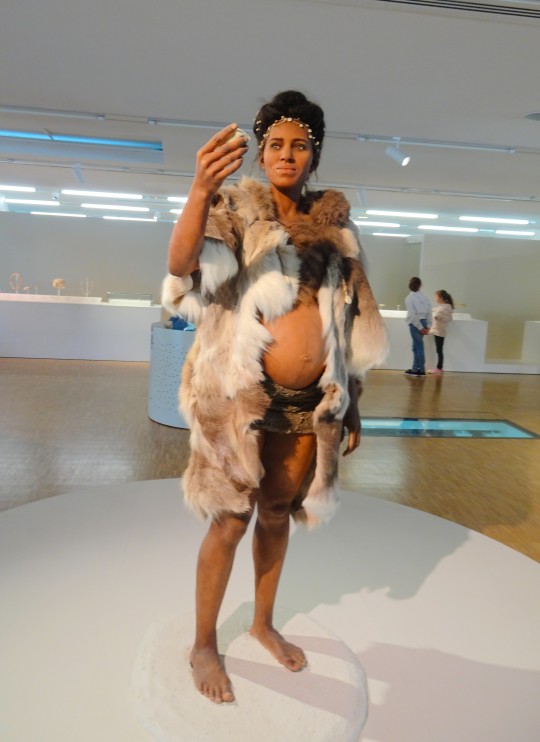
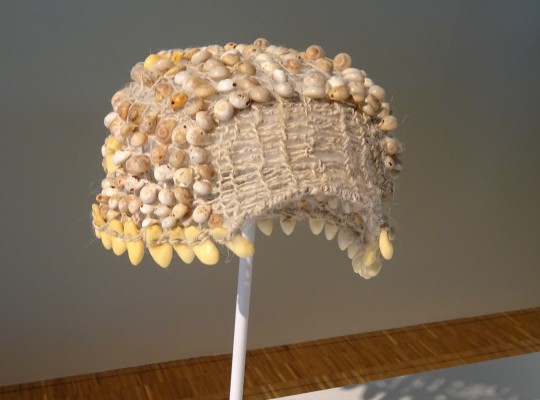





Marseille. Après avoir visité la réplique de la Grotte Cosquer dans la Villa Méditerranée, on passe au musée :
- reconstitution d’une femme préhistorique de l’époque
- coiffe de la Dame du Cavillon, coquillages Cyclope, craches de cerf (qu’est-ce ???), résille d'ortie - Vintimille, -24000 ans
- vue sur le Port de la Joliette
- diorama 3D : “la Grotte de l’Os”, avec les Grands Pingouins et les Calanques à l’époque, au niveau marin bien plus bas que maintenant.
- reconstitution possible d’une barque néolithique
- vue sur le Cirque
retour chez moi par le tram !
#marseille#grotte cosquer#cosquer#néolithique#préhistoire#dame du cavillon#parure#la joliette#port#port de la joliette#diorama#grotte de l'os#grand pingouin#cirque#tram#christine
6 notes
·
View notes
Text

“An impressive shell cameo parure comprised of necklace, earrings (day-to-night with removable drops), brooch, and 2 bracelet panels (for stitching onto ribbon), in its original box. Made in Italy, early nineteenth century.”
74 notes
·
View notes
Text




Jour 8: Parure inspiration Noël, chaine en acier inoxydable, pendentif fiole en verre (contenu brillant dans le noir, voir photos) et flocon de neige en bois. 2 modèles disponibles sur ma boutique: https://4-nutty-addict.sumupstore.com/article/parure-fiole-tempete-de-neige
0 notes
Text
Schmuck(e) Auktionen: München am 04. & 05.12.2024
Noch rechtzeitig als Überraschung für den Nikolausstiefel kann man im Auktionshaus Neumeister am 4. Dezember überwiegend historischen Schmuck aus dem 19.Jahrhundert und im Auktionshaus Quittenbaum am 5.Dezember ausgesuchte Autorenschmuckstücke ersteigern. Da klopft doch das Herz höher! Anhänger mit großem Amethyst, Rubinen, Saphiren, Perlen und Emaille, wahrscheinlich Frankreich, um 1870-1880 |…
#Auktion#Autorenschmuck#Claude Lalanne#edelsteine#feine Juwelen#Georg Dobler#Gerd Rothmann#Gold#Hermann Jünger#historischer Schmuck#Manfred Bischoff#München#Neumeister#Parure#Peter Chang#Peter Scubic#Philippe Sajet#Quittenbaum#Robert Smit#Schmuck#Silber#Versteigerung#Yves Saint Laurent
0 notes

